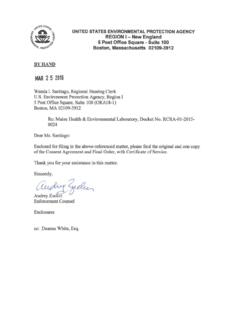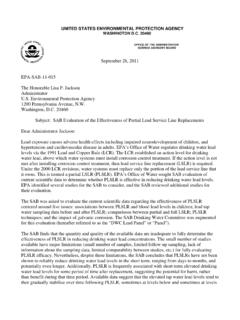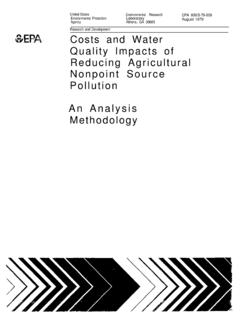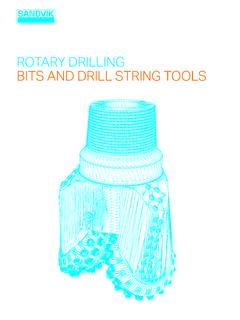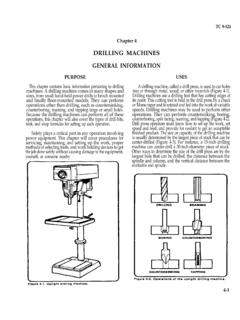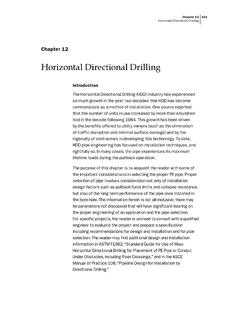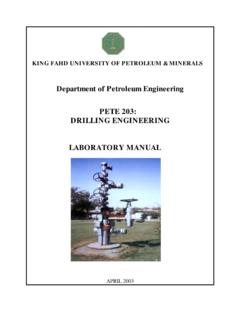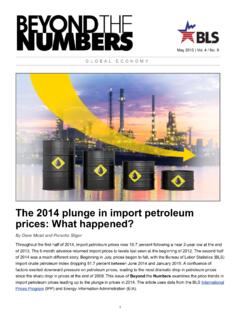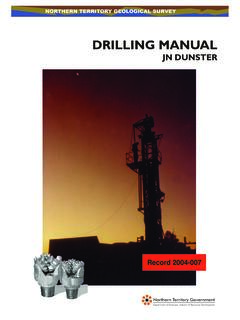Transcription of Exemption of Oil and Gas Exploration and Production Wastes ...
1 Exhibit 28 Envtl. Prot. Agency, Office of Solid Waste, EPA530-K-01-004, Exemption of Oil and Gas Exploration and Production Wastes from Federal Hazardous Waste Regulations (2002) Exemption of Oil and Gas Exploration and Production Wastes from Federal Hazardous Waste RegulationsPrinted on paper that contains at least 30 percent postconsumer 10/22/2002 5:06 PM Page 39 Cover photo: Oil Production , Bakersfield, Californiaoil& 10/22/2002 5:06 PM Page iiThis publication provides an understanding of the exemptionof certain oil and gas Exploration and Production (E&P) Wastes from regulation as hazardous Wastes under Subtitle Cof the Resource Conservation and Recovery Act (RCRA).
2 The information contained in this booklet is intended to fur-nish the reader with: A basic background on the E&P Exemption . Basic rules for determining the exempt or non-exempt status of Wastes . Examples of exempt and non-exempt Wastes . Status of E&P waste mixtures. Clarifications of several misunderstandings aboutthe 10/22/2002 5:06 PM Page 1 Answers to frequently asked questions. Recommendations for sensible waste management. Additional sources of information. The American Petroleum Institute (API) estimated that 149million barrels of drilling Wastes , billion barrels of pro-duced water and million barrels of other associatedwastes were generated in 1995 from Exploration and produc-tion (E&P) generated, managing these Wastes in a manner thatprotects human health and the environment is essential forlimiting operators legal and financial liabilities and alsomakes good business sense.
3 Operators must also determine ifthe waste is subject to hazardous waste regulations. At timesthis determination is misunderstood and can lead to improp-er waste management decisions. 2 drilling waste volumes are directly related to the level ofdrilling activity. API data show that the total footagedrilled for all oil and gas wells dropped from mil-lion feet in 1985 to 118 million feet in 1995, a decreaseof 60 percent. A corresponding drop in the volume ofdrilling waste, from 361 million barrels in 1985, to 149million barrels in 1995, was the other hand, as hydrocarbons from producingwells deplete, produced water volumes typically has estimated that the average volume of producedwater increased from 6 barrels of water per barrel of oilin 1985, to barrels of water per barrel of oil in 10/22/2002 5:06 PM Page 23 Prudent waste management decisions, even for nonhaz-ardous Wastes , should be based on the inherent nature of thewaste.
4 Not all waste management options are appropriate forevery waste. Operators also should be familiar with state andfederal regulations governing the management of hazardousand nonhazardous preferred option for preventing pollution is to avoid gen-erating Wastes whenever possible (source reduction).Examples include process modifications to reduce waste vol-umes and materials substitution to reduce toxicity. oil& 10/22/2002 5:06 PM Page 3 Understanding the procedures for determining the exempt ornonexempt status of a waste is a valuable tool, especially foroperators who choose to develop voluntary waste manage-ment plans.
5 When these procedures are used in conjunctionwith a knowledge of the nature of the waste, the operator willbe better prepared to develop site-specific waste manage-ment plans and to manage E&P Wastes in a manner that pro-tects human health and the 10/22/2002 5:06 PM Page 4In December 1978, EPA proposed hazardous waste manage-ment standards that included reduced requirements for sev-eral types of large volume Wastes . Generally, EPA believedthese large volume special Wastes are lower in toxicity thanother Wastes being regulated as hazardous waste underRCRA.
6 Subsequently, Congress exempted these Wastes fromthe RCRA Subtitle C hazardous waste regulations pending astudy and regulatory determination by EPA. In 1988, EPAissued a regulatory determination stating that control of E&Pwastes under RCRA Subtitle C regulations is not , E&P Wastes have remained exempt from Subtitle Cregulations. The RCRA Subtitle C Exemption , however, did notpreclude these Wastes from control under state regulations,under the less stringent RCRA Subtitle D solid waste regula-tions, or under other federal regulations. In addition,although they are relieved from regulation as hazardouswastes, the Exemption does not mean these Wastes could notpresent a hazard to human health and the environment ifimproperly of the Exemptionoil& 10/22/2002 5:06 PM Page 5 Among the Wastes covered by the 1978 proposal were gasand oil drilling muds and oil Production brines.
7 The oil andgas Exemption was expanded in the 1980 legislative amend-ments to RCRA to include drilling fluids, produced water,and other Wastes associated with the Exploration , develop-ment, or Production of crude oil or natural gas.. (Geothermal energy Wastes were also exempted but are notaddressed by this publication.)According to the legislative history, the term other wastesassociated specifically includes waste materials intrinsicallyderived from primary field operations associated with theexploration, development, or Production of crude oil andnatural gas.
8 The phrase intrinsically derived from the pri-mary field operations is intended to distinguish Exploration ,development, and Production operations from transportationand manufacturing 10/22/2002 5:06 PM Page 6 With respect to crude oil,primary field operationsinclude activities occur-ring at or near the well-head and before the pointwhere the oil is trans-ferred from an individualfield facility or a centrallylocated facility to a carrierfor transport to a refineryor a respect to naturalgas, primary field opera-tions are those activitiesoccurring at or near thewellhead or at the gasplant, but before thepoint where the gas is transferred from an individual fieldfacility, a centrally located facility.
9 Or a gas plant to a carrierfor transport to market. Examples of carriers include trucks,interstate pipelines, and some intrastate field operations include Exploration , development,and the primary, secondary, and tertiary Production of oil orgas. Crude oil processing, such as water separation, de-emulsifying, degassing, and storage at tank batteries associat-ed with a specific well or wells, are examples of primary fieldoperations. Furthermore, because natural gas often requiresprocessing to remove water and other impurities prior toentering the sales line, gas plants are considered to be part ofproduction operations regardless of their location withrespect to the 10/22/2002 5:06 PM Page 78In general, the exempt status of an E&P waste depends on howthe material was used or generated as waste, not necessarilywhether the material is hazardous or toxic.
10 For example, someexempt E&P Wastes might be harmful to human health and theenvironment, and many non-exempt Wastes might not be asharmful. The following simple rule of thumb can be used todetermine if an E&P waste is exempt or non-exempt fromRCRA Subtitle C regulations: Has the waste come from down-hole, , was it broughtto the surface during oil and gas E&P operations? Has the waste otherwise been generated by contact withthe oil and gas Production stream during the removal ofproduced water or other contaminants from the product?If the answer to either question is yes, then the waste is likelyconsidered exempt from RCRA Subtitle C regulations.
